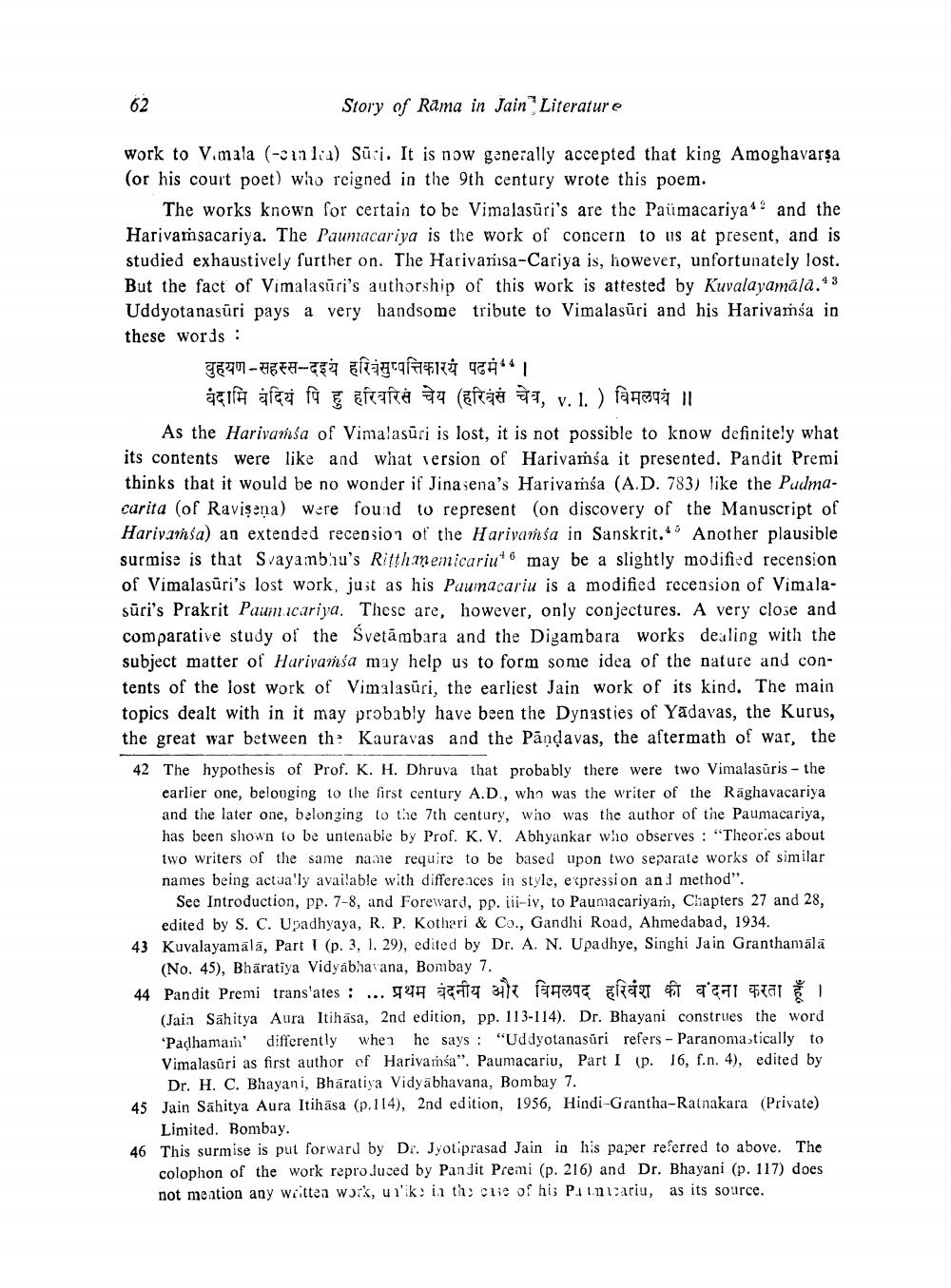________________
62
Story of Rama in Jain Literature
work to V.mala (-onlia) Sūrį. It is now generally accepted that king Amoghavarsa (or his court poet) who reigned in the 9th century wrote this poem.
The works known for certain to be Vimalasūri's are the Paümacariya"? and the Harivamsacariya. The Paumacariya is the work of concern to us at present, and is studied exhaustively further on. The Harivarisa-Cariya is, however, unfortunately lost. But the fact of Vimalasūri's authorship of this work is attested by Kuvalayamāla.4 3 Uddyotanasūri pays a very handsome tribute to Vimalasūri and his Harivamsa in these words :
वुहयण - सहस्स-दइयं हरिवंसुप्पत्तिकारय पढमं"।
Eh afcui f arafa 9 (aftas 9. v. 1.) fa ll As the Harivanía of Vimalasūri is lost, it is not possible to know definitely what its contents were like and what version of Harivamśa it presented. Pandit Premi thinks that it would be no wonder if Jinasena's Hariva mía (A.D. 783) like the Pudmacarita (of Ravişena) were found to represent (on discovery of the Manuscript of Harivamsa) an extended recension of the Harivansa in Sanskrit.Another plausible surmise is that Svayambhu's Ritthanemicariu 6 may be a slightly modified recension of Vimalasūri's lost work, just as his Paunacariu is a modified recension of Vimalasūri's Prakrit Paumacariya. These are, however, only conjectures. A very close and comparative study of the Svetāmbara and the Digambara works dealing with the subject matter of Harivamsa may help us to form some idea of the nature and contents of the lost work of Vimalasūri, the earliest Jain work of its kind. The main topics dealt with in it may probably have been the Dynasties of Yadavas, the Kurus, the great war between the Kauravas and the Pandavas, the aftermath of war, the 42 The hypothesis of Prof. K. H. Dhruva that probably there were two Vimalasūris - the
earlier one, belonging to the first century A.D., who was the writer of the Rāghavacariya and the later one, belonging to the 7th century, who was the author of the Paumacariya, has been shown to be untenable by Prof. K. V. Abhyankar who observes : "Theories about two writers of the same name require to be based upon two separate works of similar names being actually available with differences in style, expression and method".
See Introduction, pp. 7-8, and Foreward, pp. iii-iv, to Paumacariyar, Chapters 27 and 28,
edited by S. C. Upadhyaya, R. P. Kothari & Co., Gandhi Road, Ahmedabad, 1934. 43 Kuvalayamala, Part 1 (p. 3. 1. 29), edited by Dr. A. N. Upadhye, Singhi Jain Granthamala
(No. 45), Bhāratiya Vidyabhavana, Bombay 7. 44 Pandit Premi trans'ates : ... 944 au 3177 17397
azal war (Jain Sahitya Aura Itihasa, 2nd edition, pp. 113-114). Dr. Bhayani construes the word *Padhamain' differently when he says: "Uddyotanasuri refers - Paranomatically to Vimalasûri as first author of Harivamsa". Paumacariu, Part I (p. 16, f.n. 4), edited by
Dr. H. C. Bhayani, Bharatiya Vidyabhavana, Bombay 7. 45 Jain Sahitya Aura Itihāsa (p.114), 2nd edition, 1956, Hindi-Grantha-Ratnakara (Private)
Limited. Bombay. 46 This surmise is put forward by D. Jyotiprasad Jain in his paper referred to above. The
colophon of the work reproduced by Pandit Premi (p. 216) and Dr. Bhayani (p. 117) does not meation any writtea work, un'iko in thclic of his Pin ariu, as its source.




